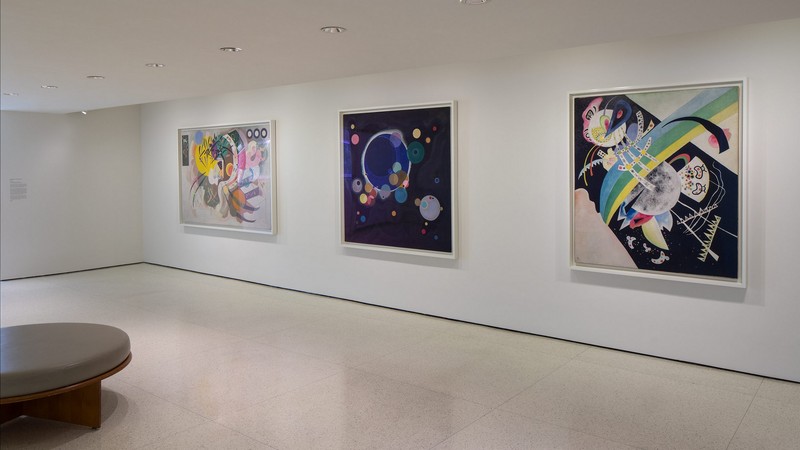Kandinsky Gallery
01 Jul 2015 - 03 Apr 2016

Кandinsky Gallery, Solomon R. Guggenheim Museum, New York, July 1, 2015–Spring 2016. Photo: David Heald
KANDINSKY GALLERY
1 July 2015 – 3 April 2016
A pioneer of abstract art and eminent aesthetic theorist, Vasily Kandinsky (b. 1866, Moscow; d. 1944, Neuilly-sur-Seine, France) broke new ground in painting during the first decades of the twentieth century. His seminal treatise Über das Geistige in der Kunst (On the Spiritual in Art), published in Munich in December 1911, lays out his program for developing an art independent from observations of the external world. In this and other texts, as well as his work, Kandinsky advanced abstraction’s potential to be free from nature, a quality of music that he admired. The development of a new subject matter based solely on the artist’s “inner necessity” would occupy him for the rest of his life.
Perhaps more than any other twentieth-century painter, Kandinsky has been linked to the history of the Solomon R. Guggenheim Museum. Hilla Rebay, artist, art advisor to Solomon R. Guggenheim, and the institution’s first director, promoted nonobjective painting above all other forms of abstraction. She was particularly inspired by Kandinsky. By 1929 Guggenheim and his wife, Irene, had begun collecting the artist’s work, and, together with Rebay, they visited Kandinsky’s studio at the Bauhaus in Dessau, Germany, in 1930. Before the trip, Rebay wrote to the artist and described Guggenheim’s new interest in the avant-garde: “Mr. G. has gotten to know [the work of] my friends Léger, Gleizes, Braque, Delaunay, Chagall, and Mondrian, but he still loves . . . yours most of all. You will find him to be a fine, great man who is open to all that is first rate, and capable of enthusiasm. A year ago he still knew nothing at all about this art, for one rarely sees good examples of abstract art in New York.” While Guggenheim particularly appreciated Kandinsky’s Bauhaus works, Rebay encouraged him to collect his work in-depth, across various media and from different periods. As a result of this discerning guidance, the Guggenheim collection, established with Solomon’s private holdings in 1937, now contains more than 150 works by this single artist.
This presentation of select works from the Guggenheim collection traces Kandinsky’s aesthetic evolution: his early beginnings in Munich at the start of the century, the return to his native Moscow with the outbreak of World War I, his interwar years in Germany as a teacher at the Bauhaus, and his final chapter in Paris.
—Organized by Tracey Bashkoff, Senior Curator, Collections and Exhibitions, and Megan Fontanella, Associate Curator, Collections and Provenance
1 July 2015 – 3 April 2016
A pioneer of abstract art and eminent aesthetic theorist, Vasily Kandinsky (b. 1866, Moscow; d. 1944, Neuilly-sur-Seine, France) broke new ground in painting during the first decades of the twentieth century. His seminal treatise Über das Geistige in der Kunst (On the Spiritual in Art), published in Munich in December 1911, lays out his program for developing an art independent from observations of the external world. In this and other texts, as well as his work, Kandinsky advanced abstraction’s potential to be free from nature, a quality of music that he admired. The development of a new subject matter based solely on the artist’s “inner necessity” would occupy him for the rest of his life.
Perhaps more than any other twentieth-century painter, Kandinsky has been linked to the history of the Solomon R. Guggenheim Museum. Hilla Rebay, artist, art advisor to Solomon R. Guggenheim, and the institution’s first director, promoted nonobjective painting above all other forms of abstraction. She was particularly inspired by Kandinsky. By 1929 Guggenheim and his wife, Irene, had begun collecting the artist’s work, and, together with Rebay, they visited Kandinsky’s studio at the Bauhaus in Dessau, Germany, in 1930. Before the trip, Rebay wrote to the artist and described Guggenheim’s new interest in the avant-garde: “Mr. G. has gotten to know [the work of] my friends Léger, Gleizes, Braque, Delaunay, Chagall, and Mondrian, but he still loves . . . yours most of all. You will find him to be a fine, great man who is open to all that is first rate, and capable of enthusiasm. A year ago he still knew nothing at all about this art, for one rarely sees good examples of abstract art in New York.” While Guggenheim particularly appreciated Kandinsky’s Bauhaus works, Rebay encouraged him to collect his work in-depth, across various media and from different periods. As a result of this discerning guidance, the Guggenheim collection, established with Solomon’s private holdings in 1937, now contains more than 150 works by this single artist.
This presentation of select works from the Guggenheim collection traces Kandinsky’s aesthetic evolution: his early beginnings in Munich at the start of the century, the return to his native Moscow with the outbreak of World War I, his interwar years in Germany as a teacher at the Bauhaus, and his final chapter in Paris.
—Organized by Tracey Bashkoff, Senior Curator, Collections and Exhibitions, and Megan Fontanella, Associate Curator, Collections and Provenance
